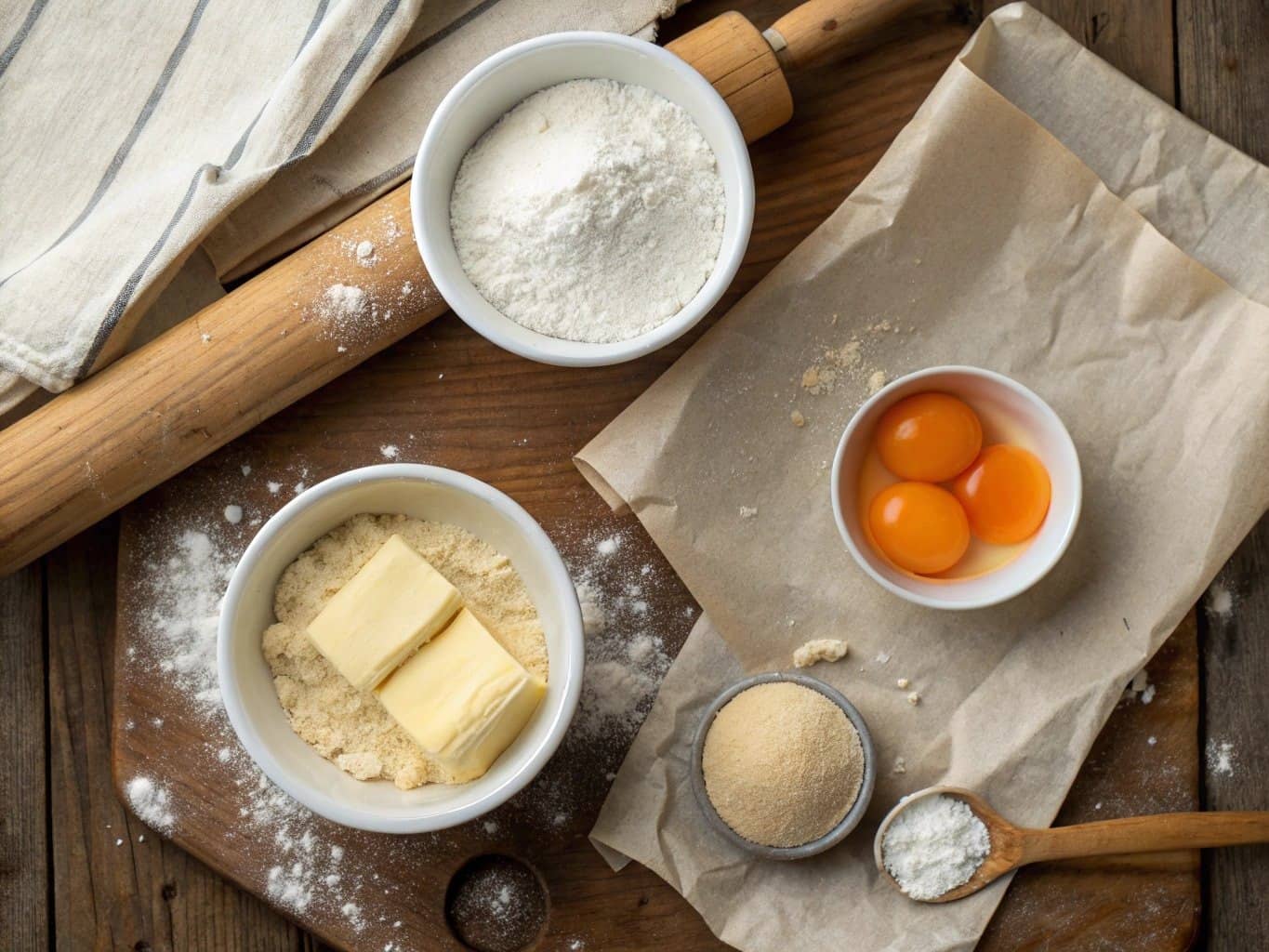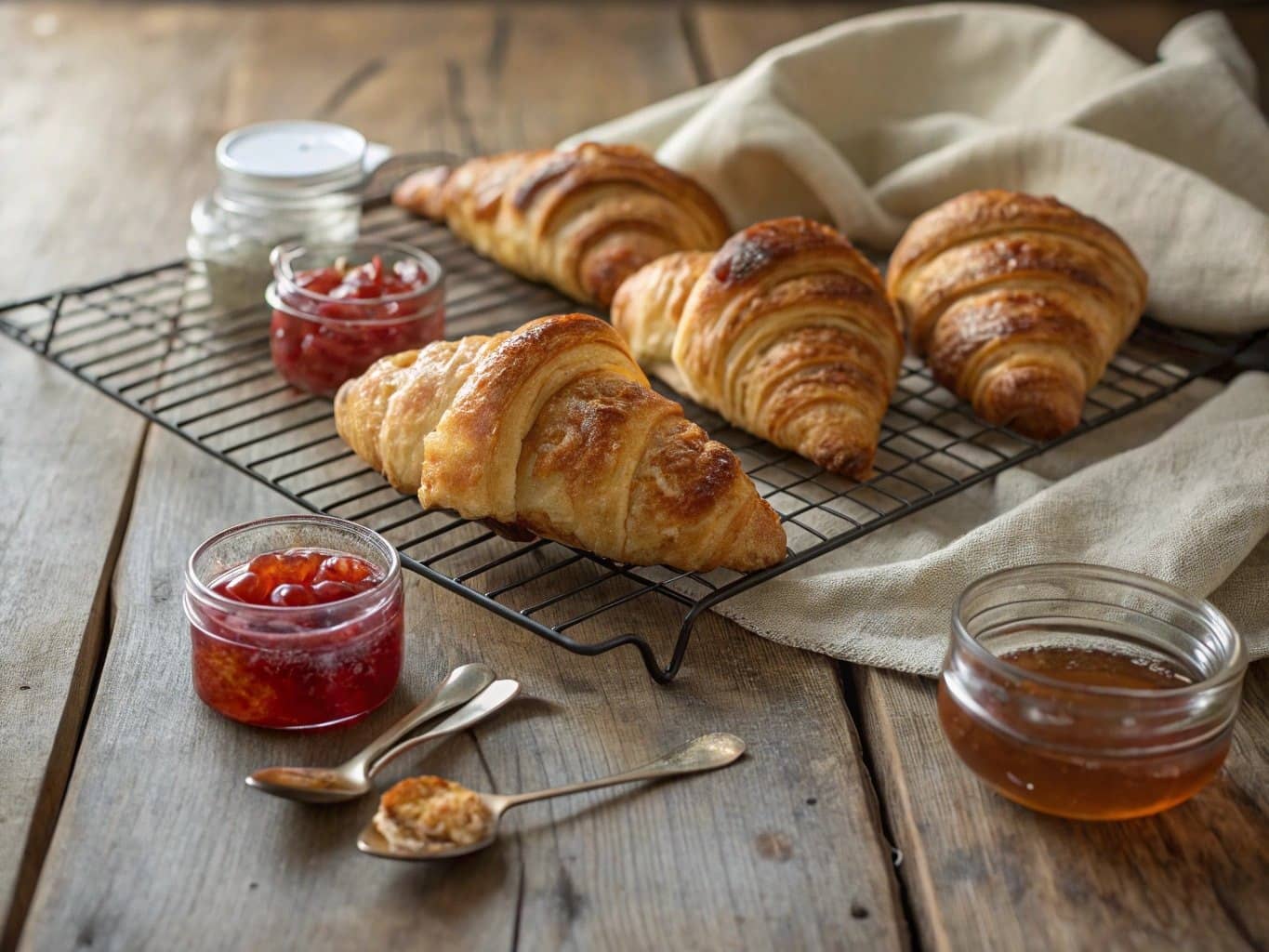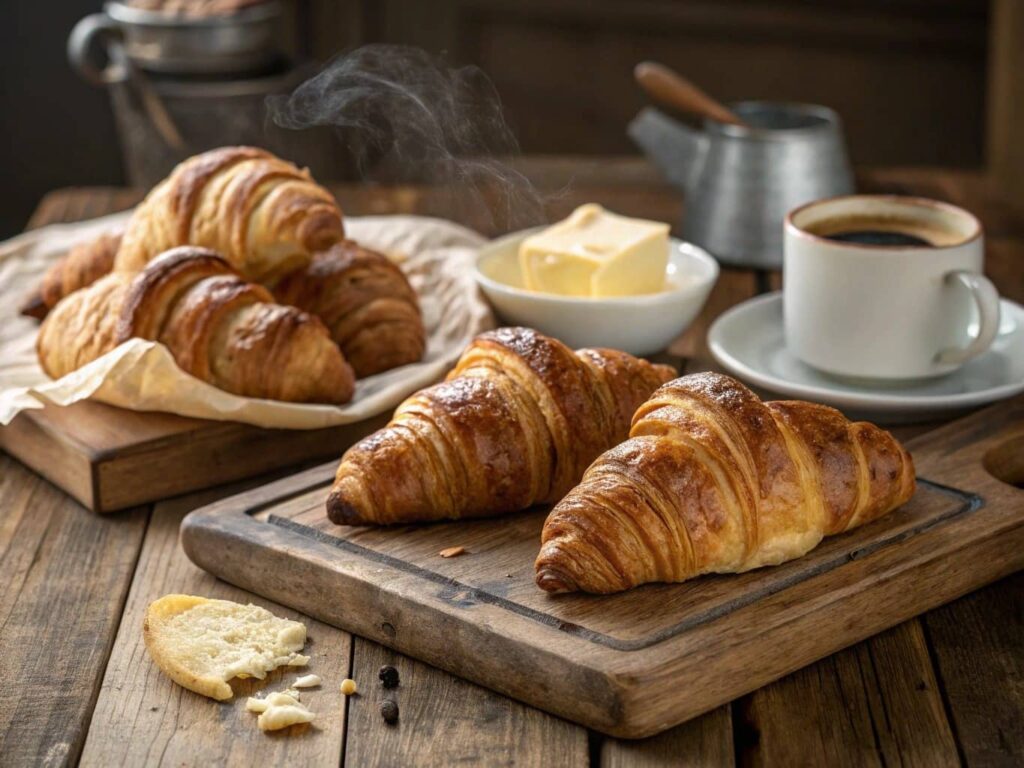Imagine waking up to the heavenly aroma of freshly baked pastries wafting through the air. One is golden, buttery, and flaky, like delicate edible layers of luxury. The other is slightly denser, softer, and gently sweet—a comforting hug in pastry form. Both look similar, but they each have a distinct personality that sets them apart.
So, what is the difference between a croissant and a gipfeli? Is it their ingredients, their preparation, or something deeper rooted in their cultural heritage? Let’s dive in and unravel the delightful secrets behind these two beloved treats! 🥐✨
Table of Contents
Introduction to Croissant and Gipfeli
Croissants and gipfelis are like cousins at a family reunion—related but with their own quirks. Croissants are widely known as a French favorite, while gipfelis are the pride of Swiss bakeries. Though they might appear similar, their ingredients, textures, and cultural roles make them stand apart.
Whether you’re grabbing a quick breakfast or indulging in a leisurely brunch, these pastries can brighten anyone’s day. But how do you decide which one to pick? Keep reading, and I’ll help you make that delicious decision by highlighting the difference between a croissant and a gipfeli.
Origins and History of Croissant and Gipfeli
The Birth of the Croissant in France
Croissants weren’t always French. Surprised? This flaky delight traces its roots back to Austria! The “kipferl”, a crescent-shaped bread, inspired the French to create the buttery, layered masterpiece we now call the croissant. By the 19th century, croissants had become a symbol of French breakfast culture.
“The croissant isn’t just food; it’s art wrapped in golden layers.”
Switzerland’s Beloved Gipfeli: A Culinary Staple
On the other hand, gipfelis are Switzerland’s own take on the crescent-shaped pastry. Their name comes from the German word “Gipfel,” meaning “peak” or “summit.” This reflects their slightly pointed ends. While less buttery than croissants, gipfelis are soft, subtly sweet, and perfect with a cup of coffee or hot chocolate.
Key Ingredients: Croissant vs. Gipfeli
What goes into making these pastries so different? Let’s peek into the kitchen and explore the distinct techniques and ingredients that set the difference between a croissant and a gipfeli. From butter content to dough preparation, each pastry has its own unique method of creation.
Traditional Ingredients of Croissant
Croissants are all about butter, flour, sugar, yeast, and milk. But the magic lies in the butter—lots of it! The dough is folded and layered with butter multiple times, creating those iconic flaky layers that make croissants a rich, indulgent treat.
Distinct Ingredients Used in Gipfeli
Gipfelis use similar ingredients but with less butter. They’re slightly less rich and sometimes include a hint of egg in the dough, giving them a more bread-like texture. This makes them a lighter choice for those who want something sweet but not too indulgent. These subtle differences contribute to the difference between a croissant and a gipfeli, influencing both their flavor and texture.
| Ingredient | Croissant | Gipfeli |
|---|---|---|
| Butter | High Amount | Moderate Amount |
| Sugar | Moderate | Low |
| Yeast | Yes | Yes |
| Milk | Yes | Yes |
| Egg (Optional) | Rarely Used | Often Used |

Preparation Techniques: Difference Between A Croissant and A Gipfeli
The Laminated Dough Technique of Croissants
Making croissants is like crafting a sculpture. The dough is repeatedly rolled and folded over butter, creating thin layers. When baked, these layers puff up, becoming crispy and golden. It’s a labor of love—and patience.
Simpler Dough Method for Gipfelis
Gipfelis skip the lamination process. Instead, the dough is shaped into crescents and baked until golden. While they lack the croissant’s flakiness, their soft, tender crumb is equally delightful. This simpler dough method is part of the difference between a croissant and a gipfeli, contributing to their unique textures.
Fun Fact: The easier dough process for gipfelis makes them a favorite for home bakers! 🏡
Shape and Size: Visual Difference Between A Croissant and A Gipfeli
Crescent Elegance of Croissants
Croissants are typically larger, with a curved, airy shape. Their golden brown crust and slightly pointed ends make them look like edible crescents floating on your plate.
Compact and Dense Design of Gipfelis
Gipfelis are more compact, with a tighter curve. Their ends are less pronounced, and they often have a smoother surface. If croissants are all about drama, gipfelis are the quiet yet dependable stars.
Texture and Flavor Profiles
Buttery Layers of the Croissant
Croissants are famous for their flaky texture and rich, buttery flavor. Each bite feels like peeling away edible paper that melts in your mouth.
Mild Sweetness of the Gipfeli
Gipfelis are softer and have a mild sweetness that’s not overwhelming. Their denser crumb pairs well with jams, honey, or a simple spread of butter.
Imagine this: Croissants are a symphony, while gipfelis are a soothing lullaby.
Cultural Significance in France and Switzerland
French Breakfast Rituals with Croissants
In France, croissants are almost a national treasure. They’re enjoyed fresh from the boulangerie, often paired with coffee or hot chocolate. Eating a croissant feels like taking a bite out of Parisian culture.
Gipfeli as a Swiss Morning Essential
In Switzerland, gipfelis are the go-to choice for busy mornings. You’ll find them in bakeries, supermarkets, and even gas stations. They’re versatile enough to be enjoyed plain, with spreads, or filled with sweet or savory delights.
Common Variations and Fillings of Croissant and Gipfeli
Popular Croissant Fillings
Croissants have evolved into versatile pastries with fillings to suit every palate. Traditional options include chocolate, almond paste, or even ham and cheese for a savory twist. Fancy a modern take? You’ll find croissants stuffed with Nutella, pistachio cream, or fruit compotes.
“Chocolate croissants are like little hugs for your taste buds!” 🍫
Favorite Gipfeli Varieties
Gipfelis may not flaunt as many variations as croissants, but they hold their own. Swiss bakeries offer them with fillings like apricot jam, vanilla cream, or hazelnut paste. Some versions come sprinkled with seeds or lightly glazed for added sweetness.
| Variation | Croissant | Gipfeli |
|---|---|---|
| Chocolate-Filled | Classic Option | Rare |
| Almond Paste | Popular | Uncommon |
| Fruit Jam | Less Common | Very Popular |
| Savory (Ham & Cheese) | Regular Offering | Occasional |
Nutritional Comparison of Croissants and Gipfelis
If you’re curious about which pastry is healthier, let’s compare their nutritional profiles.
| Nutritional Value (Per 100g) | Croissant | Gipfeli |
|---|---|---|
| Calories | 406 kcal | 320 kcal |
| Fat | 21g | 14g |
| Carbohydrates | 45g | 50g |
| Protein | 6g | 7g |
Croissants are richer due to their higher butter content, while gipfelis are slightly lighter on calories and fat. Both, however, are indulgent treats best enjoyed in moderation. Understanding the difference between a croissant and a gipfeli can help you appreciate their unique characteristics even more.
Remember, a gipfeli might feel lighter, but a croissant is worth the splurge when you crave buttery goodness. 🧈
Common Misconceptions About Croissants and Gipfelis
Are They the Same Pastry?
One of the biggest misunderstandings is thinking croissants and gipfelis are interchangeable. While they share a crescent shape, their textures, flavors, and cultural roots make them distinct. To truly understand the difference between a croissant and a gipfeli, it’s important to dive into the unique qualities of each.
Misunderstandings About Their Origins
Another misconception is that croissants are purely French. As we’ve learned, their Austrian roots play a key role in their history. Similarly, gipfelis are often mistaken for a direct copy of croissants, but they’ve grown into their own Swiss identity.
Expert Opinions and Preferences
Chefs Weigh In on Croissants vs. Gipfelis
Renowned chefs often praise croissants for their complex layering process, which makes them a technical marvel. Gipfelis, on the other hand, are appreciated for their simplicity and everyday appeal.
“If croissants are haute couture, gipfelis are your favorite cozy sweater.”
Public Preferences in Taste Tests
Taste tests often reveal divided opinions. Some prefer the richness of croissants, while others love the softer, less intense flavor of gipfelis. It all boils down to personal preference—and perhaps, mood.
Tips for Choosing and Knowing Difference Between A Croissant and A Gipfeli
When to Opt for a Croissant
If you’re in the mood for something indulgent or planning a fancy brunch, croissants are your go-to. They’re also perfect for pairing with rich spreads like brie or dark chocolate. And if you’re curious about the difference between a croissant and a gipfeli, read on to explore their unique flavors and textures!
Perfect Occasions for a Gipfeli
Looking for a quick, fuss-free breakfast? A gipfeli is ideal. It’s less flaky (goodbye, crumbs everywhere!) and works great for on-the-go snacking.
How to Make Both Pastries at Home
Why not try making these pastries yourself? Here’s a quick guide:
Step-by-Step Guide to Croissants
- Prepare a yeasted dough with flour, milk, sugar, and yeast.
- Roll out the dough and add layers of butter.
- Fold and chill the dough several times.
- Shape into crescents and let them rise.
- Bake until golden and flaky.
Warning: Making croissants requires patience, but the reward is worth every minute!
Easy Recipe for Gipfelis
- Mix flour, milk, sugar, yeast, and eggs into a soft dough.
- Roll into crescent shapes.
- Brush with egg wash for a golden finish.
- Bake until light brown and fluffy.
Fun Fact: Gipfelis are much quicker to make, perfect for beginner bakers! 👩🍳
Recipes: Make Your Own Croissants and Gipfelis
If you’ve ever dreamed of baking your own croissants or gipfelis, here’s your chance! These recipes will guide you step-by-step, whether you want to tackle the buttery challenge of croissants or enjoy the simpler process of making gipfelis. Plus, learn the key difference between a croissant and a gipfeli as you bake!
Homemade Croissant Recipe
Ingredients:
| Ingredient | Quantity |
|---|---|
| All-purpose flour | 4 cups |
| Unsalted butter | 2 cups (cold) |
| Sugar | 1/4 cup |
| Salt | 1 tsp |
| Milk | 1 1/4 cups (warm) |
| Active dry yeast | 2 1/4 tsp |
| Egg (for egg wash) | 1 (beaten) |
Instructions:
- Activate Yeast: In a bowl, dissolve yeast and sugar in warm milk. Let it sit for 5 minutes until foamy.
- Make the Dough: In a large bowl, combine flour and salt. Add the yeast mixture and mix until a dough forms. Knead until smooth. Cover and chill for 30 minutes.
- Prepare Butter Block: Place cold butter between parchment sheets and flatten into a rectangle. Refrigerate.
- Laminate Dough: Roll the dough into a rectangle and place the butter in the center. Fold the dough over the butter like an envelope. Chill for 30 minutes. Repeat the folding and chilling process 3 times.
- Shape Croissants: Roll out the dough into a large sheet and cut triangles. Roll each triangle tightly from the base to form crescents.
- Proof: Place croissants on a baking tray, cover, and let rise for 1-2 hours until puffy.
- Bake: Preheat the oven to 375°F (190°C). Brush croissants with egg wash and bake for 15-20 minutes until golden brown.
Tip: Patience is key! Allow each step to rest and chill to ensure flaky layers. 🧈
Traditional Swiss Gipfeli Recipe
Ingredients:
| Ingredient | Quantity |
|---|---|
| All-purpose flour | 3 cups |
| Butter | 1/2 cup (softened) |
| Sugar | 2 tbsp |
| Salt | 1/2 tsp |
| Milk | 1 cup (warm) |
| Active dry yeast | 2 tsp |
| Egg (for egg wash) | 1 (beaten) |
Instructions:
- Activate Yeast: In a small bowl, mix warm milk, yeast, and sugar. Allow to sit for 5 minutes until frothy.
- Mix Dough: In a large mixing bowl, combine flour and salt. Add the yeast mixture and softened butter. Knead until smooth and elastic. Cover and let it rise for 1 hour.
- Shape Gipfelis: Roll out the dough and cut into small triangles. Shape each triangle into a crescent by rolling it from the wide base.
- Proof: Arrange on a baking tray, cover with a towel, and let them rise for another 30 minutes.
- Bake: Preheat oven to 350°F (175°C). Brush each gipfeli with egg wash and bake for 12-15 minutes until light golden brown.
Fun Fact: Gipfelis are quicker to make than croissants, making them perfect for beginner bakers!
Why Bake Them Yourself?
Homemade pastries allow you to experiment with fillings, shapes, and even healthier ingredient swaps. Plus, nothing beats the smell of freshly baked croissants and gipfelis straight from your own oven. It’s a labor of love, but oh, so rewarding!
“Baking is the art of turning simple ingredients into warm memories.” 🥐✨

Where to Find Authentic Croissants and Gipfelis
Best Bakeries for Croissants Worldwide
For croissants, you can’t go wrong with bakeries in Paris like Ladurée or Poilâne. Internationally, artisanal bakeries often replicate the French style beautifully. Exploring these options is a great way to experience the difference between a croissant and a gipfeli firsthand.
Top Swiss Bakeries for Gipfelis
In Switzerland, visit local gems like Bachmann Bakery or Confiserie Sprüngli to taste authentic gipfelis. Many small-town bakeries also serve incredible versions of this Swiss favorite, showcasing the difference between a croissant and a gipfeli in texture, flavor, and cultural essence.
Frequently Asked Questions about the Difference Between Croissant and Gipfeli
What are the ingredients in a croissant?
A croissant typically includes flour, butter, milk, sugar, yeast, and a pinch of salt. The secret lies in the butter—it must be of high quality to achieve the rich flavor and flaky texture. The dough is layered with butter through a process called lamination, which creates those iconic, delicate layers.
What is a common mistake in croissants?
One common mistake is skipping or rushing the laminating process. This step involves folding and rolling the dough with butter multiple times to create the layers. If done incorrectly, the croissant can end up dense instead of light and flaky. Another error? Not letting the dough rest properly between folds, which can cause uneven baking.
How to create perfect Gipfeli every time?
To nail Gipfeli every time, focus on creating a soft, elastic dough. Allow it to rise properly before shaping it into crescents. Brush the tops with egg wash for a glossy finish, and avoid over-baking to keep the texture tender. For consistent results, measure your ingredients accurately and use fresh yeast.
What is the secret to a good croissant?
The secret is all about patience and precision. Use the best ingredients you can find, especially butter, and follow the lamination steps carefully. Ensure the dough stays cold during the process to prevent the butter from melting. And don’t forget: baking at the right temperature ensures the croissant rises beautifully and gets that golden brown crust.
Celebrating Pastry Diversity
Croissants and gipfelis might look alike, but they’re worlds apart in taste, texture, and tradition. The difference between a croissant and a gipfeli lies in their essence: croissants, with their golden, flaky layers and buttery indulgence, embody elegance and artistry. They’re the highlight of a leisurely Parisian breakfast, a true treat for the senses. On the other hand, gipfelis, with their subtle sweetness and softer texture, bring comfort and practicality to Swiss mornings. They are a no-fuss, versatile delight that’s perfect for a quick snack or a simple pairing with coffee.
Both pastries have their charm and cultural significance, making it impossible to crown one as the best. So why choose? Explore the difference between a croissant and a gipfeli by diving into the richness of a croissant on a relaxed weekend, and grabbing a gipfeli for a busy weekday morning. Each bite offers a unique experience, a taste of history, and a reason to celebrate the beauty of pastry diversity.
Indulge in the buttery luxury of a croissant, savor the gentle sweetness of a gipfeli, and let these iconic pastries transport you to the charming streets of Paris or the breathtaking peaks of Switzerland. Whether you’re a foodie or just someone who loves a good pastry, both deserve a place in your culinary journey. Treat yourself—you deserve it! 🥐✨




